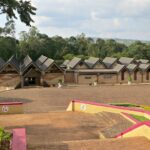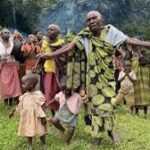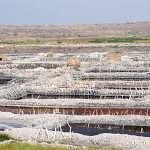The Kasubi Tombs are located 5 kilometers away from the center of Kampala in Kasubi Hill. It is the burial ground/cemetery of 4 of the last Kabakas (Kings) of Buganda). All princes and princesses who are their direct descendants are buried at the back of the main shrine. Built in the 13th century, the Kasubi tombs are just one of the 31 royal tombs spread across the Buganda Kingdom. Other smaller tombs are found in places like Kyaggwe, Singo, Busiro. The Kasubi tombs are an important historical, cultural and spiritual center for not only the Baganda people but Africa as a whole. It is one of the leading heritage sites in Uganda. Because of its cultural and national value, the tombs became a protected site by Ugandan law in 1972 though they remain registered as Buganda Kingdom property. The Kasubi tombs became a UNESCO World Heritage Site in 2001 and is one of the most visited places by tourists visiting Uganda on a safari.
Its main tomb (Muzibu- Azaala-Mpanga ) is an awesome piece of local architecture and is the largest grass thatched building on earth. The main tomb building is made out of bamboo, wood and a roof that is grass thatched. It was uniquely built with a lot of care taken to make it stand out from similar structures.
The main grass thatched building was initially the palace of Kabaka Mutesa 1 (35th King) before it was turned into a tomb on his death in 1884. The three kings after him chose not to follow a tradition requiring them to be buried in their own palace and were laid to rest at the Kasubi tombs. The tombs are divided into 3 main sections. The first section is the area with the main structure (western side) housing the tombs of the 4 Kings. The second section behind the main structure has several smaller buildings and graveyards. The third section is an open farmland.
A wooden gate (Bujjabukula) with a grass-thatched roof and woven reeds welcome visitors to the Kasubi tombs. Traditional guards are positioned at the entrance and towards the Olugya (courtyard) which is close to the Ndoga- Obukaba (a round house where traditional drums are kept). As one approaches the main courtyard, they will see the smaller houses that were built for the Kings wives, other members from the royal family, the spiritual guardian (Nalinya) and her deputies.
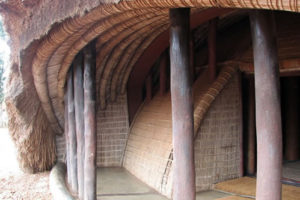
The walls at the main structure/tomb are decorated with bark cloth and several mats where visitors can sit. The photos of all the Kings and stuffed leopard skin can also be seen by visitors to the man building. The Leopard was a pet of Mutesa 1. After Mutesa’s death, the Leopard became difficult to control and killed several people. It was eventually killed and its skin filled with material to retain its live shape. Other notable items include rings of spears holding the roof together, each representing the 52 clans of Buganda. Each clan is responsible for a particular task at the tomb. The Ngeye (Colobus Monkey) clan are responsible for maintaining the thatched roofs at the tombs. As members of a clan age, they pass on their skills to younger ones who take on the task of maintaining the tombs.
Some sections of the main tomb are not accessible to everyone. The Kibira (sacred forest) is a sacred area of the main structure where the spirits of the Kings are believed to dwell. The place can only be accessed by widows of the Kings, the Katikkiro and some members of the royal family. Not even the reigning Kabaka can go there. Four rooms are built close to the Kibira housing the four wives of the dead kings. Each dead Kabaka has a living wife. Their task is to look after the dead king. The wives are chosen from the clans of the departed Queens. You might be interested in tips for planning your Uganda Trip.
History of the Baganda and the Kings buried at the Kasubi Tombs
To understand the cultural significance of the Kasubi tombs, we need to understand the history of the Baganda people and their kings. The Buganda Kingdom was among the most powerful in Africa before the coming of foreign settlers. The Kingdom had a rich history and civilization dating back to the early 13th Century. The Baganda belong to the Bantu group which spread all the way up to Southern Africa. Legend has it that the first King of Buganda was Kintu. He had a wife Nambi who was handed over to him after he impressed her father Ggulu (the god of the sky) with great deeds. Kintu did not die but disappeared into the Magonga forest.
After Kintu, several Kings ruled Buganda. Unfortunately, information (dates) about their time as Kings are not known. It was only during the reign of Kabaka Suuna II (1836 – 1856) that correct dates where recorded. The Kings of Buganda preferred building their palaces on top of major hills throughout the Kingdom. This was help them get a clear view of their dominion, spot approaching enemies and stop any internal rebellions. When they passed on, the tradition was to bury the Kings body in one shrine and the Jawbone in another site. It is still believed that the jawbone contained their spirit. The Baganda like most tribes in Africa believe that once someone dies, their spirit remains. The dead Kabaka would communicate to his successors through a spirit medium. When he King or a member of his house dies, a successor is chosen immediately after burial. Several rituals are performed to appease the dead Kings spirit including sacrificing animals and exchanging gifts (including money).
There are four kings buried at the Kasubi tombs:-
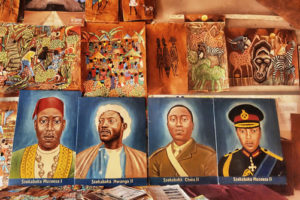
Mutesa I (1835 to 1884). Muteesa 1 was born around 1835 and became King in 1856. He was the 35th Kabaka of Buganda and the first to be buried in the Kasubi tombs. He built his palace in the very spot where the Kasubi tombs are located. Mutesa was a very powerful King Muteesa with more wives than any of his predecessors. When he saw his brothers as a threat to his rule, he imprisoned them in a large trench. Many of them died in the trench living him unchallenged. The reign of Muteesa 1 occurred at a time when foreigners starting coming to East Africa in large numbers. Because of this, he became the first king to be influenced by foreign cultures. He became a Muslim after coming into contact with the Arabs who had come all the way from the East African coast to look for ivory and slaves. Mutesa 1 also showed great interest in Europeans. He hosted John Speke (the first white visitor to Buganda) in 1862 and Henry Morton Stanley in 1875. This was at a time when the scramble for Africa was setting pace. Mutesa one allowed his Christian and Muslim friends to convert his royal staff but ensured that they never threatened his authority. Mutesa 1 died in 1884 and was buried at the Kasubi tombs. Before he died, Mutesa told his subjects not to remove his jaw bone for a separate burial. In doing this, he was the first king to deviate from an ancient tradition.
Basamula Mwanga II (1867 -1903): After Mutesa’s death in 1884, his son Mwanga succeeded him. He was the last King to rule a truly independent Buganda. Mwanga became Kabaka when the influence of foreigners had grown rapidly. He saw Christianity and other foreign religions as a threat to his rule and killed many of the Muslims and Christians who had converted during his father’s regime in 1886. After these massive killings of the Uganda Martyrs, his Christian and Muslim chiefs became concerned and combined forces to remove him from power. Mwanga was forced to go into exile where he joined forces with the King of Bunyoro (Kabalega) to resist the British colonialists and get back to the throne. His attempts were futile and they were defeated and exiled in the Seychelles Island. Mwanga died in the island in 1903. By then he had become a Christian and been named Daniel. His remains where send back in 1910 and buried at the Kasubi tombs. His burial at the tombs once again broke with the ancient traditions and turned the place into and important burial ground for future kings.
Kabaka Daudi Chwa II (1896 – 1939): When Mwanga died, he was replaced by his one-year-old son Daudi Chwa in 1897. Chwa was assisted by Christian regents until he reached the age of 18. His reign was low key and he was not as powerful as the Kings before him. When Daudi Chwa died in 1939, he too was buried at the Kasubi tombs thus strengthening the reputation and importance of the tombs culturally and spiritually.
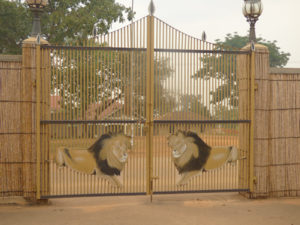
Fredrick Walugembe Muteesa II (1924 – 1969): When Daudi Chwa died, he was succeeded by his son Mutesa II. A conflict developed between the King and Sir Andrew Cohen over amendments to the Buganda Agreement of 1900. The King was exiled in England after this disagreement with the representative of the colonial government. After his return from exile in 1955, the king became the president (constitutional) of Uganda on the day of independence. Tension rose between Mutesa and the more powerful Prime Minister Milton Obote. His palace was attacked by government troops in 1966 led by Idi Amin under the orders of Milton Obote. The King escaped and fled to England where he lived in exile till his death in London 1969. In 1971, His remains were brought back and buried at the Kasubi tombs.
Visiting the Kasubi Tombs
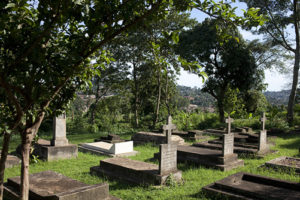
The Kasubi tombs are one of the top tourist attractions in Kampala city. Getting to the Kasubi Tombs site takes about 15 minutes from Kampala city center if there is no jam. To reach the tombs, pass along the Makerere University main gate and then join the road to Nakulabye. After the Nakulabye round about, join the Hoima road and drive for about one Kilometer. Turn left and climb the Kasubi Hill. After reaching the very top of the hill branch to Masiro Road and you will see the gate/entrance to the tombs. After being checked by the royal guides and filling in their details, visitors are issued a ticket. Entrance fee to the Kasubi royal tombs is about 5 Dollars or 10,000 Uganda shillings. The fee goes into the maintenance of the tombs and paying off workers at the site. You are also assigned a Guide to take you around after paying the entrance fee.
Facts about the Kasubi tombs
- The Kasubi tomb is the only UNESCO World heritage site in Kampala city.
- There are several traditional ceremonies carried out though the course of the year apart from the burial ceremonies of royal members of the family. Among the ceremonies is that of welcoming the new moon. Some of the more spiritual ceremonies like consulting mediums are performed secretly (away from visitors). The shrine is frequented by traditional medicine women and men from all over Buganda who come to get blessings for their work from the Kings spirit. The current Kabaka of Buganda rarely visits the tombs unless he is traveling out of the country and needs the blessings of his dead ancestors.
- Kabaka Mutesa II renovated the tombs in 1938 to include some modern materials like steel, concrete and brick structures but ensured that the traditional materials remained dominant.
- The Kasubi tombs is also the go to place for those who are interested in traditional bark cloth from the Ngo clan and grass thatching skills from the Ngeye clan.

